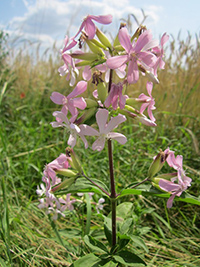Table of Contents
In ancient times, women used the soaproot plant to wash clothes, especially wool ones. Today, it is usually employed externally for skin and hair care.
- Introduction: Soapwort is, as its name suggests, a plant with a “soapy” consistency. A member of the clove family, soapwort is a low-growing perennial shrub with a thick tap root used for health problems and for making soaps.
- Ingredients: Saponaria Officinalis

Soaproot Plant Scientific Facts
- Other names: Bouncing bet, bruisewort, dog cloves, old maids’ pink, soapwort.
- French: Saponaire.
- Spanish: Saponaria.
- Environment: Common on roadsides and slopes of humid regions throughout Europe and North America.
- Description: This vigorous plant of the Cariofilaceae family grows from 30 to 60 cm high. It has an upright stem and a large rhizome. Its pink flowers have a pleasant aroma.
- Parts of the plant used medicinally: The whole plant.
Healing Properties and Warning

The whole plant, mainly its root and rhizome, contains a saponin called saporrubine. This saponin has expectorant, diuretic, cholagogue, and depurative properties. Saponins can dissolve fats into water, producing foam.
Its most crucial action is expectorant because it can make bronchial secretions more fluid. However, although it is effective with respiratory afflictions, given its toxicity when internally used, it has been substituted with safer plants. In external application, it is helpful to combat skin eczema and rashes and wash delicate hair.
WARNING! Do not exceed the recommended dose for internal use since this plant may produce poisoning.

How to use Soaproot
- Decoction with 15 g per liter of water. Drink up to two cups daily, sweetened with honey.
- Lotions or compresses soaked in a decoction more concentrated than the one internally used.
- Poultices with sliced leaves and/or roots.
- Hair washing, with a decoction of 20 g per liter of water.
Frequently Asked Question
What are saponins, and how do the saponins in the soaproot plant work?
Saponins are naturally occurring plant compounds with soap-like properties. When mixed with water, they form a foam. Saponins in soaproot have potential anti-inflammatory, antioxidant, and immune-boosting effects. Research suggests they may interact with gut bacteria and offer benefits for several health conditions.
Is scientific evidence supporting using soaproot plants for arthritis or joint pain?
While traditionally used for joint pain, there’s limited direct scientific evidence specifically on soaproot for arthritis. However, saponins, in general, have shown anti-inflammatory effects that might be helpful.
Can the soaproot plant help with skin conditions like eczema or psoriasis?
The potential benefits of soaproot for skin conditions are primarily based on traditional use. Its anti-inflammatory effects, and gentle cleansing action could be soothing. However, always consult a dermatologist before using soaproot on open or severe skin conditions.
Does soaproot have any known effects on cholesterol?
Some preliminary studies suggest saponins, in general, and possibly those in soaproot, may help lower cholesterol levels.
I’ve heard soaproot can boost the immune system. Is this true?
Saponins have some immune-modulating properties, which might help regulate the immune system.
Can the soaproot plant be used for respiratory issues like coughs or congestion?
Soaproot was traditionally used as an expectorant, meaning it may help loosen mucus in the respiratory system. While limited, some studies suggest saponins might have a modest beneficial effect on coughs.
Are there any known side effects of using soaproot?
Soaproot is generally considered safe when used in moderation. However, it can cause stomach upset or irritation in some people, especially if consumed raw. Excessive intake could be harmful.
Is soaproot safe to use during pregnancy or breastfeeding?
Not enough is known about soaproot’s safety for pregnant or breastfeeding women. It’s best to avoid using it unless expressly advised by a qualified healthcare professional.
Can soaproot interact with any medications?
The potential for Soaproot interactions with medication is not fully understood. Prior consultation with a doctor is essential before using soaproot, especially if you are taking any drugs.
Where can I find reliable information about preparing and using soaproot?
Consult trusted resources like university websites, herbal medicine databases, and publications from reputable ethnobotanical organizations.
DISCLAIMER: All content on this website is presented solely for educational and informational objectives. Do not rely on the information provided as a replacement for advice, diagnosis, or treatment from a qualified medical expert. If you are pregnant, nursing, or have any preexisting medical concerns, talk to your doctor before using any herbal or natural medicines.
REFERENCES
- George D. Pamplona-Roger, M.D. “Encyclopedia of Medicinal Plants.” George D. Pamplona-Roger, M.D. Encyclopedia of Medicinal Plants. Ed. Francesc X. Gelabert. Vols. 1 San Fernando de Henares: Editorial Safeliz, 2000. 333. Print. [soaproot plant]
- National Institutes of Health (NIH): https://www.ncbi.nlm.nih.gov/pmc/articles/PMC9964560/
- WebMD: https://www.fs.usda.gov/wildflowers/plant-of-the-week/chlorogalum_pomeridianum.shtml
- Journal of Chiropractic Medicine: https://www.ncbi.nlm.nih.gov/pmc/articles/PMC2928447/
- Frontiers in Pharmacology: https://www.ncbi.nlm.nih.gov/pmc/articles/PMC9964560/
- Memorial Sloan Kettering Cancer Center: https://www.mskcc.org/cancer-care/diagnosis-treatment/symptom-management/integrative-medicine/herbs
Last update on 2024-07-23 / Affiliate links / Images from Amazon Product Advertising API




